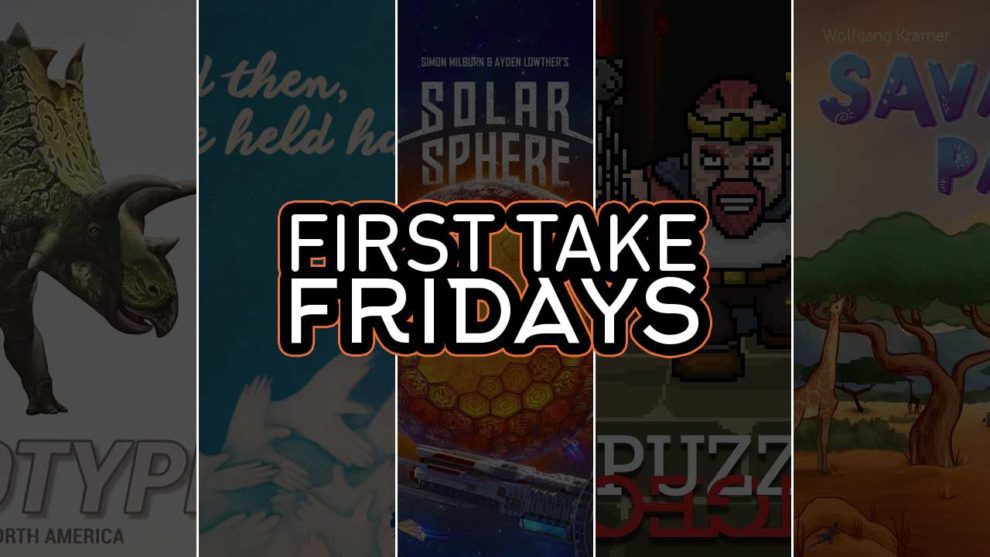Holotype: Mesozoic North America – David Wood
Holotype is a worker placement game about digging up fossils, conducting research, and publishing papers on new dinosaur species. You have three different types of workers – a Paleontologist, a Grad Student, and a Field Assistant – that you will send out to conduct one of five different actions. The type of worker used affects the strength of the action, and whether you can bump another worker, even your own. Each player is trying to score victory points by publishing papers on new species and by completing both their own secret Personal objective and Global objectives.
Holotype is an ideal family game. It’s easy enough for teens to learn, yet still fun for us adults. It can accommodate up to five players, with a minimum of downtime between player turns. That means it can be played in two hours or less even at 4 or 5 players. The components are beautiful, especially the specimen cards. The number of cards, and the fact that there are five different card types used in the game, means there is a lot of variability from game-to-game.
I usually play wargames and complex Euros but backed this game on Kickstarter because I love dinosaurs. I’m glad I did.
Ease of entry?:
★★★★★ – No sweat
Would I play it again?:
★★★★★ – Will definitely play it again
Read more articles from David Wood.
…and then, we held hands – Bob Pazehoski, Jr.
I know it’s unwise to chase an abstract game because of its theme, but I couldn’t resist. The premise of …and then, we held hands is a couple working out their issues by navigating an emotional field to a place of unity. Come on, that’s fascinating. Two players move their tokens through three concentric rings, landing on spaces by playing cards from either their own visible hand or their partner’s. The goal is to unlock and reach the center. Oh, and it’s silent.
My wife and I had an interesting time with our first play. We talked a little bit (don’t worry, the rules said that’s OK) just to clarify rules and hammer out details, but we honored the code as much as possible. I really appreciate the way David Chircop created a system that requires full attention from both parties. I also love that the system requires invading another person’s “emotional stores” to reach the target. There is a fair amount of tension as the deck dwindles and the various cards are needed by all. Flippant behavior equals disaster here. I’m not at all disappointed. There are variants to increase the difficulty. I’m sure we’ll try those too before long. Maybe not the best game ever, but definitely a curious creation.
Ease of entry?:
★★★★★ – No sweat
Would I play it again?:
★★★★★ – Will definitely play it again
Read more articles from Bob Pazehoski, Jr.
Solar Sphere – David McMillan
Solar Sphere is a spacefaring game about subcontractors, working for a megacorporation to build a Dyson sphere around a sun in order to harness its energy for humanity’s needs. It’s a dice rolling, dice placement game with a smattering of set collection, resource collection, and resource management thrown into the mix. In the game players roll their personal dice and then take turns placing those dice onto the game’s various locations to carry out their associated actions: collecting resources, hiring crew members, fighting off the rebels, adding to the sphere, and manipulating your drones (the currency spent to do many of the actions in the game). The game ends after six rounds and the player with the most points wins.
First off: this is a beautifully produced game and the artwork is fantastic. If I’d backed this on Kickstarter and received it as a final product, I would be most pleased. The only thing that I think could have used a bit of polish is the rule book. There were a lot of questions on my first playthrough and, even though the answers were there, it wasn’t always easy to find them. That detracted from the experience somewhat, but it was still enjoyable overall.
Watch out for my upcoming review.
Ease of entry?:
★★★★☆ – The odd bump or two
Would I play it again?:
★★★★★ – Will definitely play it again
Read more articles from David McMillan.
Puzzle Dungeon – Tom Franklin
A solitaire card game where you’re playing as one of 25 double-sided heroes (for a total of 50) with the goal of defeating a set number and type of monsters in the dungeon. That dungeon is laid out in four columns, with five monsters each.
To defeat these monsters, you’ll work with an opening hand of six cards along with another six laid out left-to-right for your Arsenal. Monsters each have the icons of the suits needed to defeat them. However, you can only use the right-most card in the Arsenal and you don’t get to automatically replenish your hand of cards. And, of course, you don’t have enough cards to defeat every monster.
Puzzle Dungeon is a small, portable game that doesn’t take up a lot of room on a table. It’s fun, challenging, and you’ll rarely ever just play one game at a sitting.
Ease of entry?:
★★★★☆ – The odd bump or two
Would I play it again?:
★★★★★ – Will definitely play it again
Read more articles from Tom Franklin.
Savannah Park – Justin Bell
After giving Caldera Park a spin recently, it was fun to go back in time (all the way to 2021) to try Savannah Park, Capstone’s more family-friendly Kiesling and Kramer design with bush fires, tiles, somewhat wonky artwork, and meerkats.
I liked Caldera Park a bit more than Savannah Park, but Savannah Park gets the edge as a game my kids could pick up and ideally sort through the animal area-majority requirements tied to scoring. The rules are so straightforward: starting with a grid of 33 tiles (and a few empty spaces), take turns moving one tile called out by the current player to an empty space somewhere else on the grid. Keep single tile animals away from single bush fires, and try to keep your grass and tree spots empty to score extra end-game points. The difference between the two games? I would only play one of these regularly with adults.
Ease of entry?:
★★★★★ – No sweat
Would I play it again?:
★★★☆☆ – Wouldn’t suggest it, but would happily play it














Add Comment